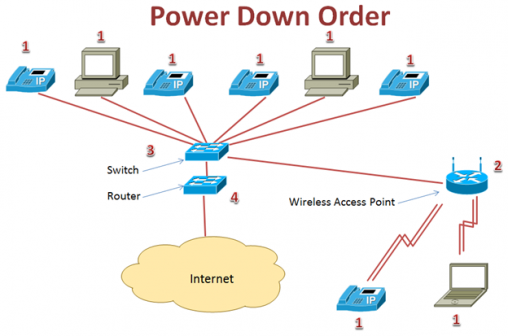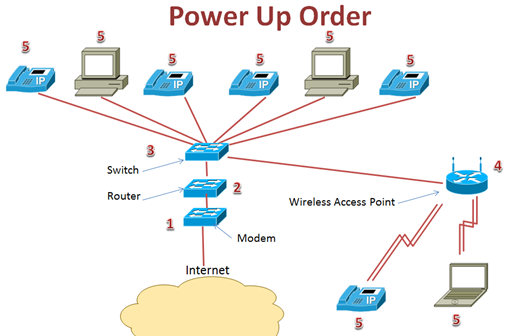How to Power Cycle Network
Note: If available, it is recommended that you have an IT or networking professional complete your network power cycle. If performed in the wrong sequence, network power cycling could introduce new problems in addition to those you are trying to clear. All network components must be powered down starting from the endpoints (computers, phones, tablets, etc.) and working one level at a time toward the your Internet interface. Then, power up slowly in reverse.
Objective
To power cycle the network.
Applies To
- Network
- Power Cycle
Procedure
Power Down

Ensure that all network cabling stays intact and plugged in (except for power-over-ethernet devices, which requires unplugging to power off).
- Power down all phones and computers. (For larger setups with a lot of phones, completely powering down phones may not be necessary. See power up instructions below.)
- Power down wireless access point(s), if applicable.
- Power down the switch.
- Power down the router.
- If Internet service is provided via cable or DSL and delivered through a standalone modem, power the modem down last.
- If the modem has a battery backup, remember to remove it as well (per manual or ISP instructions).
- Wait at least one minute after powering down the final device before powering up again.
Power Up

Wait at least one minute before powering up each subsequent device.
- Power up standalone modem (if applicable). Wait for the modem to begin broadcasting. (The indicator light--Cable, Online, Ready)
- Power up the router (or modem-router combo). Wait for the router to begin broadcasting. (Check indicator light, if available.)
- Power up switch.
- Power up wireless access point(s), if applicable.
- Power up all computers and phones. (If phones were not powered down, after power cycling the rest of the network, soft reboot the phones via the device menu.)
